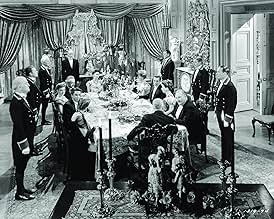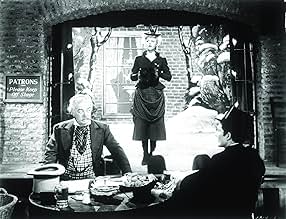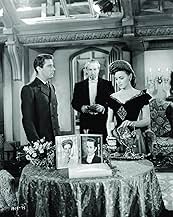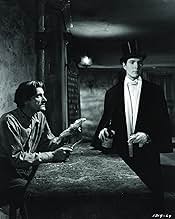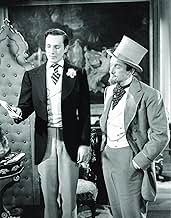VALUTAZIONE IMDb
7,5/10
15.355
LA TUA VALUTAZIONE
Un giovane corrotto mantiene in qualche modo la sua bellezza giovanile, ma un dipinto speciale rivela gradualmente la sua bruttezza interiore a tutti.Un giovane corrotto mantiene in qualche modo la sua bellezza giovanile, ma un dipinto speciale rivela gradualmente la sua bruttezza interiore a tutti.Un giovane corrotto mantiene in qualche modo la sua bellezza giovanile, ma un dipinto speciale rivela gradualmente la sua bruttezza interiore a tutti.
- Vincitore di 1 Oscar
- 3 vittorie e 4 candidature totali
Renee Carson
- Young French Woman
- (as Renie Carson)
Lilian Bond
- Kate
- (as Lillian Bond)
Devi Dja
- Lead Dancer
- (as Devi Dja and Her Balinese Dancers)
Recensioni in evidenza
This wonderfully atmospheric retelling of Oscar Wilde's chilling novel is one of the best horror films ever made. It outdoes DRACULA and FRANKENSTEIN because it is about a man -- not a monster. Yet the monster IS the man -- and hides within all of us. The story works even more effectively than the similar plot in Robert Louis Stevenson's STRANGE CASE OF DR. JEKYLL AND MR HYDE because here we have the dual sides of a man portrayed not as two separate characters but as two reflecting images -- like two mirrors facing each other, sending the images out to infinity. The painting itself is one of the most horrifing images ever created in films -- a surreal reflection of what each of us can become if we lose our humanity and replace it with careless egotism.
Like 'The Importance of Being Earnest', Oscar Wilde's only novel 'The Picture of Dorian Grey' is one of his most famous works for very good reason. It is philosophical essentially in nature, but also very chilling, dripping in atmosphere and full of Wilde's sparkling wit.
This 1945 film adaptation had so much going for it, with the involvement of great actors like George Sanders and Angela Lansbury for one thing. 72 years on, it's still one of the best overall versions of 'The Picture of Dorian Grey' there is/. Surprisingly, for film adaptations of classic literature made in the "classic era" it's pretty faithful, but 'The Picture of Dorian Grey' (1945) is actually even more successful on its own terms.
It may not be flawless, but it comes close. Donna Reed's character feels very tacked on and Reed, despite looking radiant, looks, sounds and acts out of place. Peter Lawford, in an admittedly limited role, spends his entire screen time looking bewildered and like he had little idea what to do with what he had.
Don't on the other hand let the pacing put you off. It is deliberate and measured, but to me it was never dull or too slow. The atmosphere, the performances and Wilde's dialogue were instrumental in making the film compelling and they shine brilliantly.
Visually, 'The Picture of Dorian Grey' (1945) is notably striking. As elegant as the costumes are, how classy and moodily atmospheric the lighting is and how sumptuous the Gothic set design is, it's the outstanding cinematography (that enhances everything so much) that's the star. The music score is resolutely haunting, also with inspired use of Beethoven, Mozart and Chopin, and the direction has immense sophisticated style.
Wilde's writing shines firmly to the fore as one would expect, some great lines that have full impact. Even with more measured pacing, the storytelling is rich in chilling atmosphere and class with the impact of the portrait having a truly startling effect.
All the acting is very strong and one of 'The Picture of Dorian Grey's' best elements. Sanders has the best lines (classic Wilde witticisms and cynical but witty observations) and the most interesting character (like a human Mephistopheles Oscar Wilde-style), and Sanders' performance is very like his Oscar-winning performance in 'All About Eve' five years later, a once in a lifetime role that he was born to play and it is difficult to imagine anybody else deliver those lines the way Sanders did so effortlessly. Lansbury is both chirpy and touching, plus she has rarely looked so young or more beautiful, her rendition of "Good Bye Little Yellow Bird" wrenches the heart also.
Hurd Hartfield's muted performance may be unimpressive or controversial, and it is easy to overlook him in favour of the juicier supporting roles. To me though, the mute inexpressive quality of his acting added quite vastly to the deceptively chilling nature of the role itself. Lowell Gilmore also stands out.
Overall, a near classic and one of the better film adaptations of Wilde's work, if one is looking for elegance, atmosphere and great production values, writing and performances look no further. 9/10 Bethany Cox
This 1945 film adaptation had so much going for it, with the involvement of great actors like George Sanders and Angela Lansbury for one thing. 72 years on, it's still one of the best overall versions of 'The Picture of Dorian Grey' there is/. Surprisingly, for film adaptations of classic literature made in the "classic era" it's pretty faithful, but 'The Picture of Dorian Grey' (1945) is actually even more successful on its own terms.
It may not be flawless, but it comes close. Donna Reed's character feels very tacked on and Reed, despite looking radiant, looks, sounds and acts out of place. Peter Lawford, in an admittedly limited role, spends his entire screen time looking bewildered and like he had little idea what to do with what he had.
Don't on the other hand let the pacing put you off. It is deliberate and measured, but to me it was never dull or too slow. The atmosphere, the performances and Wilde's dialogue were instrumental in making the film compelling and they shine brilliantly.
Visually, 'The Picture of Dorian Grey' (1945) is notably striking. As elegant as the costumes are, how classy and moodily atmospheric the lighting is and how sumptuous the Gothic set design is, it's the outstanding cinematography (that enhances everything so much) that's the star. The music score is resolutely haunting, also with inspired use of Beethoven, Mozart and Chopin, and the direction has immense sophisticated style.
Wilde's writing shines firmly to the fore as one would expect, some great lines that have full impact. Even with more measured pacing, the storytelling is rich in chilling atmosphere and class with the impact of the portrait having a truly startling effect.
All the acting is very strong and one of 'The Picture of Dorian Grey's' best elements. Sanders has the best lines (classic Wilde witticisms and cynical but witty observations) and the most interesting character (like a human Mephistopheles Oscar Wilde-style), and Sanders' performance is very like his Oscar-winning performance in 'All About Eve' five years later, a once in a lifetime role that he was born to play and it is difficult to imagine anybody else deliver those lines the way Sanders did so effortlessly. Lansbury is both chirpy and touching, plus she has rarely looked so young or more beautiful, her rendition of "Good Bye Little Yellow Bird" wrenches the heart also.
Hurd Hartfield's muted performance may be unimpressive or controversial, and it is easy to overlook him in favour of the juicier supporting roles. To me though, the mute inexpressive quality of his acting added quite vastly to the deceptively chilling nature of the role itself. Lowell Gilmore also stands out.
Overall, a near classic and one of the better film adaptations of Wilde's work, if one is looking for elegance, atmosphere and great production values, writing and performances look no further. 9/10 Bethany Cox
The key word for this movie is elegance. The cast move through sumptuous sets with the males dressed in immaculately tailored dress suits and the women exquisitely gowned. It seems that all the aristocrats lived in homes the size of Buckingham palace with high ceilinged rooms and magnificent staircases. They exchange Oscar Wilde epigrams in the cultured tones of the British upper classes.
Some great performances. Hurd Hatfield, an extremely handsome actor with a limited range ,gives the best one of his career as does George Sanders as the cynical Lord Henry Wotton, and a young Angela Lansbury is very moving (especially when she sings "The Little Yellow Bird").
One (very small) criticism. The color shots of the Dorian Gray portrait showing his degradation don't match the high standards of the rest of the design, they look more like pages from a horror comic. I think the producer's, with their obviously high budget, could have used a more imaginative artist.
As I say a small criticism. This a great film of psychological horror.
Some great performances. Hurd Hatfield, an extremely handsome actor with a limited range ,gives the best one of his career as does George Sanders as the cynical Lord Henry Wotton, and a young Angela Lansbury is very moving (especially when she sings "The Little Yellow Bird").
One (very small) criticism. The color shots of the Dorian Gray portrait showing his degradation don't match the high standards of the rest of the design, they look more like pages from a horror comic. I think the producer's, with their obviously high budget, could have used a more imaginative artist.
As I say a small criticism. This a great film of psychological horror.
It's hard to say what it is about "The Picture of Dorian Gray" that I enjoyed so much, but I did like it. Hurd Hatfield at first seems miscast and ineffective as the titular character, but somewhere around the one hour mark, his one and only expression begins to grow on you until you feel just as unnerved by his presence as those who come in contact with him in the story. George Sanders--from what I've seen--played one character his enter career but played it so well, and his performance in this film is no exception. Angela Lansbury is surprisingly sympathetic as the sad and timid singer. The only one in the cast who really doesn't work is Donna Reed. Her character feels tacked on, and she isn't allowed to do much but look faithful and beautiful.
The film is shot wonderfully, and Harry Stradling's cinematography gives the East End scenes a dark, atmospheric counter balance to the rather plain and flat interiors of Dorian's home. The swinging lamp was a nice touch and reminded me of "Psycho"'s finale.
I suppose my only criticism is toward the end, the story introduced one or two characters without giving them proper context or background (I'm thinking of the Allen Campbell character). I'm assuming Dorian "convinces" him to take part in his plans because of some sort past homosexual tryst, but it seemed unfair to bring him in they way he was, have him serve the role he does, and then disappear so quickly without explanation. And speaking of suggested themes: Is it just me, or could you make an argument that Dorian is Jack the Ripper? Maybe it's actually pretty obvious or maybe I'm just interpreting too much into the story, but that's what I got out of it.
P.S. I had the opportunity to see the actual painting from the film during an Ivan Albright exhibit at the Metropolitan Museum of Art in 1997. It's even more gruesome in person.
The film is shot wonderfully, and Harry Stradling's cinematography gives the East End scenes a dark, atmospheric counter balance to the rather plain and flat interiors of Dorian's home. The swinging lamp was a nice touch and reminded me of "Psycho"'s finale.
I suppose my only criticism is toward the end, the story introduced one or two characters without giving them proper context or background (I'm thinking of the Allen Campbell character). I'm assuming Dorian "convinces" him to take part in his plans because of some sort past homosexual tryst, but it seemed unfair to bring him in they way he was, have him serve the role he does, and then disappear so quickly without explanation. And speaking of suggested themes: Is it just me, or could you make an argument that Dorian is Jack the Ripper? Maybe it's actually pretty obvious or maybe I'm just interpreting too much into the story, but that's what I got out of it.
P.S. I had the opportunity to see the actual painting from the film during an Ivan Albright exhibit at the Metropolitan Museum of Art in 1997. It's even more gruesome in person.
It is a mystery. Or is it mind over matter? The power of a mysterious painting depicted in this timeless tale of Oscar Wilde's imagination -- probing the depth of life's meaning.
It's costume drama, story began in London 1886. Definitely has an element of intrigue -- "a painting with a life of its own". It's eerie. It's dramatic. Its theme is scary. Such is a "deadly" wish of the main character, Dorian Gray: "If only the picture (a portrait of Dorian Gray) can change, and I can always be as I am now. I'd give my soul for that." Dorian Gray's obsession with youth became eternal youth.
Imagine that as time goes by, he will always stay the same rich attractive young man that he is -- never grow old, while the picture will take on the changes -- his soul and character. Conscience, no longer he has -- the picture took it on. The story describes how Dorian Gray spends his life henceforth and the consequences that entail.
A very young Angela Lansbury, after her debut in George Cuckor's 1944 "Gaslight", portrays the innocent young actress Sibyl Vane from the poor side of town. The bet between the characters of George Sanders and Hurd Hatfield brought to mind the cruel intentions of Neil LaBute's 1997 "In the Company of Men". George Sanders is the cynical callous Lord Henry Wotton. The events all happen in a seemingly civil manner, immersed in the society of the rich. Have and have-nots are juxtaposed.
The film is essentially in Black and White, with only the specific content of the picture of Dorian Gray in color when we see it through Dorian's eyes.
It's another B/W classics gem, well-cut and impeccably presented. It encompasses sentiments and all elements: mystery, intrigue, love lost, friendships, regrets, and fear. Dorian Gray with a tormented inside -- pining for the return of his soul. Is this the Devil's advocate? You see no hell depicted as in Vincent Ward's 1998 "What Dreams May Come", or Woody Allen's 1997 "Deconstructing Harry" or Taylor Hackford's 1998 "The Devil's Advocate". No glamorous, elaborate take on the Devil, but the atmosphere provided that suggestion. There's no special effects, yet you can feel the twistedness: a man asking for help within yet unable to help himself because he's a lost soul. The temperature of the movie seems like being in 10 degree Celsius -- cold in sentiment and tone. There was a glimmer of warmth -- it flickered and faded with the innocent Sibyl Vane character.
The subject matter is timeless even though the film was made in 1945. The story is fascinating in spite of the pace which may not be at breakneck speed as in today's action packed, sound effects filled movies.
You can say it's pseudo sci-fi -- a foreboding tale it is. By and by, Dorian Gray's unchanging mask-like face reminds me of "Mr. Sardonicus" (William Castle's 1961). His behaviors are no longer placid -- gradually turning into hideous evils. This film questions one's probity. The mystery of life is to live it not to attain immortality. How uninteresting it'd be to be changeless and ageless? (John Boorman's 1974 sci-fi "Zardoz" with Sean Connery and Charlotte Rampling came to mind). Growth and change are intrinsic elements of life. Life and death go hand in hand cyclically. A truly worthwhile effort from writer/director Albert Lewin.
It's costume drama, story began in London 1886. Definitely has an element of intrigue -- "a painting with a life of its own". It's eerie. It's dramatic. Its theme is scary. Such is a "deadly" wish of the main character, Dorian Gray: "If only the picture (a portrait of Dorian Gray) can change, and I can always be as I am now. I'd give my soul for that." Dorian Gray's obsession with youth became eternal youth.
Imagine that as time goes by, he will always stay the same rich attractive young man that he is -- never grow old, while the picture will take on the changes -- his soul and character. Conscience, no longer he has -- the picture took it on. The story describes how Dorian Gray spends his life henceforth and the consequences that entail.
A very young Angela Lansbury, after her debut in George Cuckor's 1944 "Gaslight", portrays the innocent young actress Sibyl Vane from the poor side of town. The bet between the characters of George Sanders and Hurd Hatfield brought to mind the cruel intentions of Neil LaBute's 1997 "In the Company of Men". George Sanders is the cynical callous Lord Henry Wotton. The events all happen in a seemingly civil manner, immersed in the society of the rich. Have and have-nots are juxtaposed.
The film is essentially in Black and White, with only the specific content of the picture of Dorian Gray in color when we see it through Dorian's eyes.
It's another B/W classics gem, well-cut and impeccably presented. It encompasses sentiments and all elements: mystery, intrigue, love lost, friendships, regrets, and fear. Dorian Gray with a tormented inside -- pining for the return of his soul. Is this the Devil's advocate? You see no hell depicted as in Vincent Ward's 1998 "What Dreams May Come", or Woody Allen's 1997 "Deconstructing Harry" or Taylor Hackford's 1998 "The Devil's Advocate". No glamorous, elaborate take on the Devil, but the atmosphere provided that suggestion. There's no special effects, yet you can feel the twistedness: a man asking for help within yet unable to help himself because he's a lost soul. The temperature of the movie seems like being in 10 degree Celsius -- cold in sentiment and tone. There was a glimmer of warmth -- it flickered and faded with the innocent Sibyl Vane character.
The subject matter is timeless even though the film was made in 1945. The story is fascinating in spite of the pace which may not be at breakneck speed as in today's action packed, sound effects filled movies.
You can say it's pseudo sci-fi -- a foreboding tale it is. By and by, Dorian Gray's unchanging mask-like face reminds me of "Mr. Sardonicus" (William Castle's 1961). His behaviors are no longer placid -- gradually turning into hideous evils. This film questions one's probity. The mystery of life is to live it not to attain immortality. How uninteresting it'd be to be changeless and ageless? (John Boorman's 1974 sci-fi "Zardoz" with Sean Connery and Charlotte Rampling came to mind). Growth and change are intrinsic elements of life. Life and death go hand in hand cyclically. A truly worthwhile effort from writer/director Albert Lewin.
Lo sapevi?
- QuizIvan Le Lorraine Albright's famous painting of the decayed Dorian Gray, which took approximately one year to complete, is now owned by the Art Institute of Chicago, where it has been on display for many years. Albright's twin brother Malvin, better known as a sculptor, was also commissioned to create a painting of the young Dorian for this movie, although his work went unused. The March 27, 1944, issue of Life Magazine included a story and photos of the brothers working on their paintings for this movie. Henrique Medina created the initial portrait of young Dorian that sets the story in motion.
- BlooperAt approximately 34:35 into the film, the time on the clock in the room suddenly changes from just after 2 o'clock to 3 o'clock. Then at approximately 37:00 it moves back to 2:05 and then to 2:09 as Dorian continues to play the piano.
- Citazioni
Lord Henry Wotton: "If I could get back my youth, I'd do anything in the world except get up early, take exercise or be respectable."
- Versioni alternativeSome prints are slightly edited, omitting Dorian's prayer and Lord Henry's line, "Heaven forgive me" in the final scene.
- ConnessioniFeatured in The Cinematographer (1951)
- Colonne sonoreGood-Bye, Little Yellow Bird
(uncredited)
Lyrics and Music by C.W. Murphy and William Hargreaves
Performed by Angela Lansbury
I più visti
Accedi per valutare e creare un elenco di titoli salvati per ottenere consigli personalizzati
Dettagli
- Data di uscita
- Paese di origine
- Sito ufficiale
- Lingua
- Celebre anche come
- El retrato de Dorian Gray
- Luoghi delle riprese
- Azienda produttrice
- Vedi altri crediti dell’azienda su IMDbPro
Botteghino
- Budget
- 3.500.000 USD (previsto)
- Tempo di esecuzione1 ora 50 minuti
- Colore
- Proporzioni
- 1.37 : 1
Contribuisci a questa pagina
Suggerisci una modifica o aggiungi i contenuti mancanti


